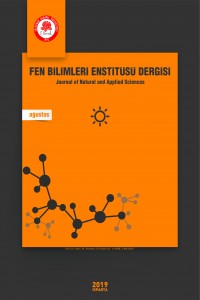Abstract
This study deals with the investigation of the
effects of fiber orientation angles on the analysis of angle of twist of
laminated composite plates under cantilever boundary conditions with left edge
clamped and remaining edges free (C-F-F-F). Numerical twisting angle analyses
were conducted based on Taguchi’s L8 ortogonal array. The plates were designed
using 8 plies and each two plies was determined to be a control factor. The
fiber orientation angles in each control factor were assumed to vary from 100
to 800 through the axial direction. Analysis of signal-to-noise (S/N) ratio was
performed to see the effects of fiber angles and to determine the optimum
levels for minimum twisting angle. Analysis of Variance (ANOVA) was applied to
analyze the significant control factors and percent contributions on the
twisting angle results. Regression analysis was employed mathematically in
order to see the effects of the fiber angles on the response. According to
ANOVA result, the most effective control factors were found to be D with 87.51
%, C with 10.26 %, A with 1.22 %, and B with 0.04 % respectively.
Keywords
References
- [1] Qatu, M.S., Leissa, A.W., 1991. Vibration studies for laminated composite twisted cantilever plates, International Journal of Mechanical Sciences, 33(1991), 927-940.
- [2] Sahu, S., Asha, A., Mishra, R., 2005. Stability of laminated composite pretwisted cantilever panels, Journal of reinforced plastics and composites, 24(2005), 1327-1334.
- [3] Taşdelen, M.E., Keleştemur, M.H., Şevkat, E., 2016. Torsional behaviour and finite element analysis of the hybrid laminated composite shafts: comparison of VARTM with vacuum bagging manufacturing method, Advances in Materials Science and Engineering, 2016(2016), 1-8 Article ID 9490375.
- [4] Badie, M.A., Mahdi, E. Hamouda, A.M.S., 2011. An investigation into hybrid carbon/glass fiber reinforced epoxy composite automotive drive shaft. Materials & Design, 32(3), pp.1485-1500.
- [5] Sevkat, E., Tumer, H., Kelestemur, M.H., Dogan, S., 2014. Effect of torsional strain-rate and lay-up sequences on the performance of hybrid composite shafts. Materials & Design, 60, pp.310-319.
- [6] Sevkat, E., Tumer, H., 2013. Residual torsional properties of composite shafts subjected to impact loadings, Materials & Design, 51(2013), 956-967.
- [7] Yam, L.H., Wei, Z., Cheng, L., Wong, W.O., 2004. Numerical analysis of multi-layer composite plates with internal delamination, Computers & Structures, 82(2004), 627-637.
- [8] Ross, P.J., 1996. Taguchi techniques for quality engineering: loss function, orthogonal experiments, parameter and tolerance design. McGraw-Hill International Editions, 2nd Edition, New York, USA, 1996.
- [9] ANSYS, 2010. ANSYS Help Guide, V.13
Abstract
Bu çalışma sol kenarı tutulu ve kalan kenarları
serbest (C-F-F-F) ankastre sınır şartlı tabakalı kompozit plakaların burulma
açı analizi üzerinde fiber oryantasyon açılarının etkilerinin incelenmesi ile
alakalıdır. Sayısal burulma açı analizleri Taguchi L8 ortogonal diziye bağlı
gerçekleştirilmiştir. Tabakalar 8 tabaka kullanılarak tasarlanmıştır ve her iki
tabaka kontrol faktörü olarak değerlendirilmiştir. Her kontrol faktöründeki
fiber oryantasyon açısı eksenel yönde 100’den 800 değiştiği varsayılmıştır. Minimum
burulma açısı için optimum seviyeleri karar vermek ve fiber açılarının etkisini
görebilmek için sinyal gürültü oran analizi gerçekleştirilmiştir. Varyans
analizi (ANOVA) burulma açı sonuçları üzerinde önemli kontrol faktörleri ve
katkı oranları analiz etmek için uygulandı. Matematiksel olarak yanıtlar
üzerinde fiber açılarının etkilerini görebilmek için regresyon analizi
uygulanmıştır. ANOVA sonucuna göre en efektif kontrol faktörleri sırasıyla
%87.51 ile D, % 10.26 ile C, % 1.22 ile A ve % 0.04 ile B olarak bulunmuştur.
Keywords
References
- [1] Qatu, M.S., Leissa, A.W., 1991. Vibration studies for laminated composite twisted cantilever plates, International Journal of Mechanical Sciences, 33(1991), 927-940.
- [2] Sahu, S., Asha, A., Mishra, R., 2005. Stability of laminated composite pretwisted cantilever panels, Journal of reinforced plastics and composites, 24(2005), 1327-1334.
- [3] Taşdelen, M.E., Keleştemur, M.H., Şevkat, E., 2016. Torsional behaviour and finite element analysis of the hybrid laminated composite shafts: comparison of VARTM with vacuum bagging manufacturing method, Advances in Materials Science and Engineering, 2016(2016), 1-8 Article ID 9490375.
- [4] Badie, M.A., Mahdi, E. Hamouda, A.M.S., 2011. An investigation into hybrid carbon/glass fiber reinforced epoxy composite automotive drive shaft. Materials & Design, 32(3), pp.1485-1500.
- [5] Sevkat, E., Tumer, H., Kelestemur, M.H., Dogan, S., 2014. Effect of torsional strain-rate and lay-up sequences on the performance of hybrid composite shafts. Materials & Design, 60, pp.310-319.
- [6] Sevkat, E., Tumer, H., 2013. Residual torsional properties of composite shafts subjected to impact loadings, Materials & Design, 51(2013), 956-967.
- [7] Yam, L.H., Wei, Z., Cheng, L., Wong, W.O., 2004. Numerical analysis of multi-layer composite plates with internal delamination, Computers & Structures, 82(2004), 627-637.
- [8] Ross, P.J., 1996. Taguchi techniques for quality engineering: loss function, orthogonal experiments, parameter and tolerance design. McGraw-Hill International Editions, 2nd Edition, New York, USA, 1996.
- [9] ANSYS, 2010. ANSYS Help Guide, V.13
Details
| Primary Language | English |
|---|---|
| Subjects | Engineering |
| Journal Section | Articles |
| Authors | |
| Publication Date | August 25, 2019 |
| Published in Issue | Year 2019 Volume: 23 Issue: 2 |
Cite
Cited By
e-ISSN :1308-6529
Linking ISSN (ISSN-L): 1300-7688
All published articles in the journal can be accessed free of charge and are open access under the Creative Commons CC BY-NC (Attribution-NonCommercial) license. All authors and other journal users are deemed to have accepted this situation. Click here to access detailed information about the CC BY-NC license.

